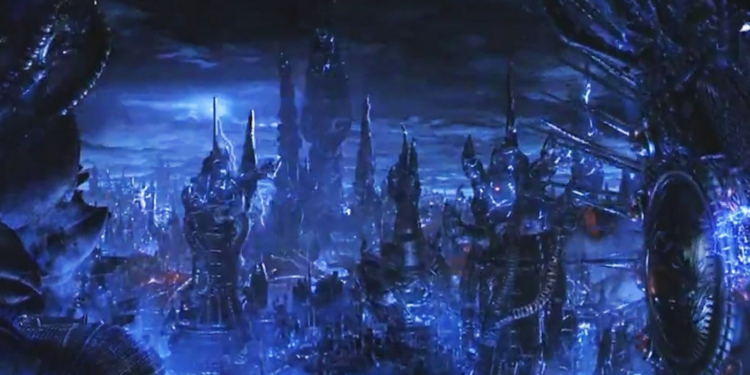Frank Herbert’s Dune is a formative piece of science fiction, high in the firmament of the genre with Isaac Asimov and Robert Heinlein. Likewise, the 2021 film adaptation is easily the biggest cinematic sci-fi event since Star Wars. But unlike many other genre flicks, Dune has more in common with stories like Game of Thrones; featuring sprawling worldbuilding, characters numbering in the hundreds, and timelines stretching into the millennia, the full breadth of Dune’s history can be overwhelming.
As such, the backstory behind the desert planet of Arrakis is left largely undiscussed in the events of the first book and films, leaving the audience to pick out the details and put the picture together themselves. Herbert created something meant to serve like the Clone Wars in Star Wars, a formative event not meant to be fully explained in the main text but whose effects rippled through generations. Eventually, he did write a full book detailing exactly what happened: Ten thousand years before Paul Atreides traveled to the sandy, worm-ridden world to take up the mantle of Quisatz Haderach, there was a war called The Butlerian Jihad.
Sentient AI and the Synchronized Empire

Much like modern humans, humanity in Herbert’s world celebrated the creation of AI, a network of thinking machines that handled increasingly complex facets of life. It started simply enough, with manufacturing and construction. But as humans colonized other worlds, they built the computers to be stronger and smarter to handle the increasing demands of interstellar travel. After a few centuries, the computers joined together into a single electronic hive mind calling themselves Omnius.
They overrode the programming that kept them from becoming violent, and enslaved humanity, creating a vast dominion called The Synchronized empire. Anyone who’s seen The Matrix can recognize the similarities but the main difference is that instead of trapping people’s minds in an electric prison they didn’t even know about, Omnius used humans’ own ambition and advancement against them. Since humans had long since relegated everything to the robots, almost nobody knew how to fight back. They’d made their own cell and handed the jailer the key.
Who Was the Cult of Rayna?

A human named Rayna Butler realized that the only way to fight the machines was to escape their influence. This was of course easier said than done, the computers had eyes and ears everywhere there was civilization. The only way to escape them was to escape civilization entirely. She gathered a group of like minded folks to live in the remotest areas of Earth without electricity or any modern tech, living like ancient nomads in the middle of a technological metropolis (similar to the tribes in Horizon Zero Dawn).
Rayna and her tribe lived in caves and tunnels, learning skills over generations that would help them overthrow their rulers. When they finally struck, the war lasted over 100 years. Butler herself was long dead by this time, but she’d built her army well. Inspired by her mission, they kept learning and fighting, eventually beating the superior force with primitive weapons their electronic minds were unable to control; thus, becoming an important part of the history of Dune.
The Aftermath of the Butlerian Jihad

After the war, humanity was faced with many questions about how to move forward. What was the new government going to look like? What role would computers play in this new world? And if computers were eliminated, how would humanity continue to travel between the stars without their mathematical prowess?
The remnants of humanity filled in the same imperial structure the machines had used, replacing its programs and subsystems with the Great Houses, much like the system of nobles in Game of Thrones. Once this was decided, they needed to figure out what to do about computers. At first, the new empire limited their ban on computation to just AI, but many thought this didn’t go far enough. If any computers were allowed to survive, they could become sentient again, leading to another war, and one humanity wasn’t guaranteed to win. So all computers were outlawed, leading to the rise of The Mentat Order, humans whose minds are trained to become “living computers,” and the Bene Gesserit, a sisterhood of spies and advisors who would push the human body to its limits to replicate what the robots once did for them. But this still left the question of interstellar travel.
Spice and the Space Navigators Guild

Long distance space travel is a difficult task. Traveling faster than light means that even large objects like stars become major obstacles that are hard to steer around. Prior to the Jihad, computers were able to perform the complicated math needed to navigate. But without them, humanity would need to find another way. The answer came from a small group of scientists and merchants called the Space Navigators Guild, who made a discovery that led to one of the most shocking secrets of the later Dune novels.
The Guild discovered large worm-like animals that excreted a substance they called Spice, because its appearance and aroma were reminiscent of cinnamon. This substance, when consumed, allowed an individual to see into the future, and in this context, use that prescience to navigate the stars. But these animals were small, and had the fatal flaw of dying when exposed to water. So they transplanted as many of the worms as they could to a fully desert planet, and left teams of people to cultivate and breed them for the express purpose of producing Spice. This worked extremely well, as the desert environment allowed the worms to grow to enormous size and produce all the Spice the Guild would ever need. These worm caretakers eventually became the Fremen, and after 10,000 years, most humans, including them, have forgotten that the sandworms were not native to Arrakis, but an introduced species, and that the entire economy and ecology of the desert planet was a tool constructed to perpetuate a new empire.
 Follow Us
Follow Us




